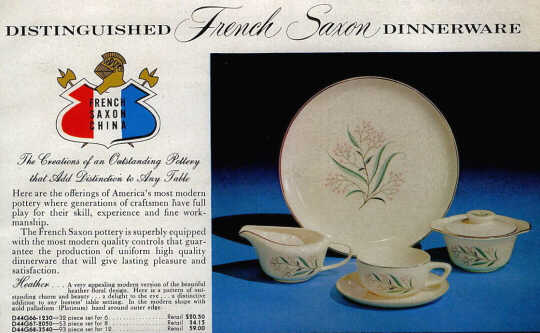 Saxon was made at Homer Laughlin in the 1960s. There were at least three patterns used on Saxon for Cunningham & Pickett: Regal, Goldcrest, and Sunglow. Some pieces were marked with an overglaze stamp with the pattern name and "Alliance China Company" in gold. Cunningham & Pickett would resell the dinnerware to supermarkets to use as giveaways and promotions. Saxon was made at Homer Laughlin in the 1960s. There were at least three patterns used on Saxon for Cunningham & Pickett: Regal, Goldcrest, and Sunglow. Some pieces were marked with an overglaze stamp with the pattern name and "Alliance China Company" in gold. Cunningham & Pickett would resell the dinnerware to supermarkets to use as giveaways and promotions.
The Saxon name most likely comes from the French-Saxon China Company of Sebring, Ohio. In fact, the Regal pattern was first used by French-Saxon. It was commonly called "Heather" in some vintage advertisements like the one on the right (though with different hollowware for the general trade).
French-Saxon closed for a brief period after its owner died in 1963. According to The Evening Review, East Liverpool, Ohio, on March 7, 1964, it was announced the French-Saxon plant was acquired by Royal China.
By 1964, HLC was already producing many patterns for Cunningham & Pickett so It is reasonable to conclude HLC got the contract to make Regal.
While there is a strong connection between French-Saxon, Cunningham & Pickett, and Homer Laughlin with respect to Regal, the same may not be true about Goldcrest and Sunglow. Company records indicate those two patterns were offered in the mid-1960s after French-Saxon was sold.
|